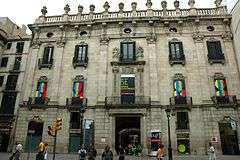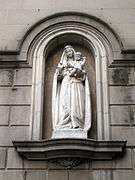Virreina Palace
| Virreina Palace | |
|---|---|
 The palace's frontage | |
 Location of the Virreina Palace within Barcelona. | |
| General information | |
| Type | Historical Building |
| Location | Barcelona, Catalonia, Spain |
| Coordinates | 41°22′57″N 2°10′18″E / 41.382492°N 2.171667°ECoordinates: 41°22′57″N 2°10′18″E / 41.382492°N 2.171667°E |
| Construction started | 1772 |
| Completed | 1778 |
The Virreina Palace (Catalan: Palau de la Virreina; Spanish: Palacio de la Virreina) is a building in the city of Barcelona. Situated on the famous La Rambla avenue, today it houses the headquarters of the city council's Culture Institute (Institut de Cultura de l'Ajuntament de Barcelona) and hosts various temporary art exhibitions and cultural events.[1]
The palace was built, between 1772 and 1778, for Manuel d'Amat i de Junyent, who was Viceroy of Peru between 1761 and 1776. It is named for his wife, virreina meaning vicereine in the Catalan language. The architect was Carles Grau, and the palace was built in a style between baroque and rococo.[1]
On the exterior of the palace is a statue of Our Lady of the Rosary, created by Luisa Granero in 1967.[2]
Gallery
- Staircase
 Interior of the palace
Interior of the palace Statue of Our Lady of the Rosary
Statue of Our Lady of the Rosary
References
- 1 2 "La Virreina Centre de la Imatge". Turisme de Barcelona. Retrieved 2013-12-03.
- ↑ "Mare de Déu del Roser 1967" (in Catalan). Ajuntament de Barcelona. Retrieved 2013-12-03.
External links
| Wikimedia Commons has media related to Palau de la Virreina (Virreina Palace). |
-